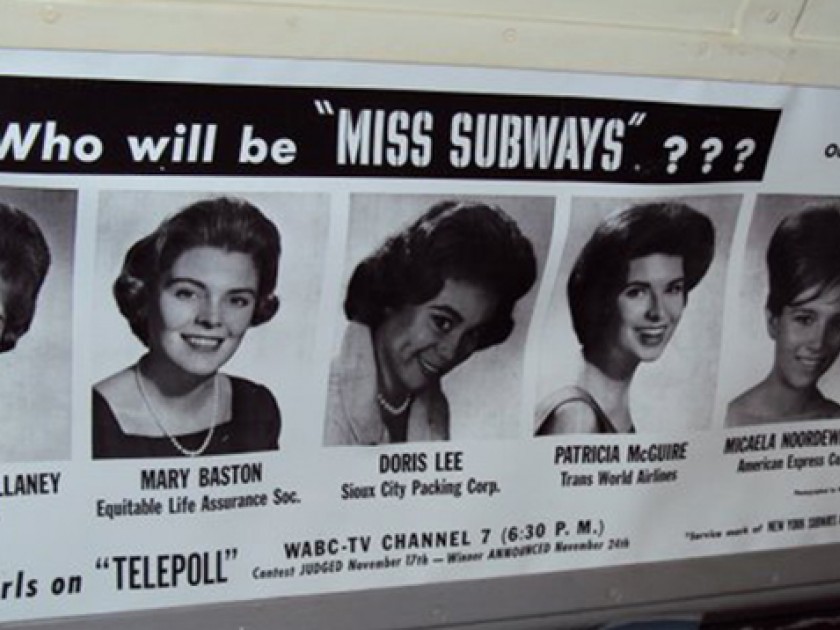
Miss Subways ad at the New York City Transit Museum by Wcnghj via Wikimedia Commons
Plastic surgeons. Wireless data plans. Personal injury attorneys. These are some of the advertisements New Yorkers and tourists see while riding the New York City subways.
Starting in the 1940s, however, and lasting until the mid-’70s, next to the ads for shaving cream and savings bonds would have been a photo of a pretty girl.
Welcome to the world of Miss Subways.
I learned about the Miss Subways contest while listening to a story on NPR several years ago, and I was blown away. A beauty pageant on the subway? Really?
I had worked in advertising for years so I thought this slice of New York City history was fascinating. And I knew immediately upon hearing the story that I wanted to write my next novel about it.
But first, I had so many questions: How did the contest come to be? Who were these Miss Subways winners? What compelled them to enter the contest in the first place? What was it like to win? And how did winning affect the rest of their lives?
My first step was research. I started with the book Meet Miss Subways: New York’s Beauty Queens 1941 – 1976 (Seapoint Books, 2012). The authors, Amy Zimmer and Fiona Gardner, painstakingly researched the history of the contest. From this book along with articles I read — from outlets ranging from The New York Times to LIFE—I learned about the history of the contest, how it worked, who was involved, its position in the NYC zeitgeist, and what it meant to a young woman at the time to win.
In the early 1940s, the Metropolitan Transportation Authority (MTA) wanted to increase rider morale and draw attention to the advertisements. So they hired noted advertising agency J. Walter Thompson, which came up with the idea of a monthly beauty contest. The famed John Robert Powers modeling agency judged the women, and the winner’s photo, along with a brief description of her ambitions and hobbies, were printed on thousands of posters that were seen by millions on their subway travels. Over the contest’s 35-year existence, 200 women would hold the title of Miss Subways.
Zimmer and Gardner also investigated the whereabouts of all 200 winners, located 41 of them, and photographed and interviewed the women, uncovering rich details of their lives before, during, and after the contest.
Winning the title of Miss Subways was a celebrated achievement and the winners often became sought after — mostly in their own neighborhoods but, on several occasions, nationally as well. Mona Freeman, the first Miss Subways in May 1941, went on to have a storied Hollywood career. Ruth Ericcson, Miss Subways December 1941, received 278 marriage proposals, and Dorothea Mate Hart, Miss Subways June 1942, received 200 tea bags.
What was revolutionary was that the Miss Subways posters relayed the winners’ ambitions, quite unlike any other beauty pageant of the time. Eileen Henry, March 1944, wanted to be a radio director. Mary Radchuck, August 1944, was studying to be an interpreter. Anne Peregrim, July 1950, hoped to become a commissioned officer in the Marine Corps. Sure, there were just as many winners who sought a career as an elementary school teacher or wanted a large family and a home in the country. But the contest was notable for celebrating women for more — okay, maybe just a little, but still — than just their appearances.
In addition, Miss Subways winners reflected the melting pot of races and religions of the city from whence they came. And though the selection of the first black Miss Subways winner, 1948’s Thelma Porter, didn’t occur without tension and racism, it’s still notable in that the first black Miss America, Vanessa Williams, wasn’t crowned until 1984, almost four decades later.
And many of the Miss Subways winners were Jewish: Ruth Lippman! Patti Freeman! Enid Berkowitz!
The most fascinating part of my research was interviewing a handful of Miss Subways winners, now in their 80s and 90s, to learn firsthand about their experiences and how winning impacted their lives.
The resulting novel, The Subway Girls (St. Martin’s Press, 2018), follows two story lines: 1949’s Charlotte Friedman (who’s named after my grandmother) competes in Miss Subways. And 2018’s Olivia learns about Miss Subways while doing research for an advertising pitch. The storylines intersect and that’s when the fun begins.
Susie Orman Schnall is the award-winning author of The Subway Girls, The Balance Project, and On Grace. She’s a frequent speaker, and her writing has appeared in publications including The New York Times, HuffPost, and Harper’s Bazaar. Susie grew up in Los Angeles, graduated from the University of Pennsylvania, and lives with her husband and three sons in New York.